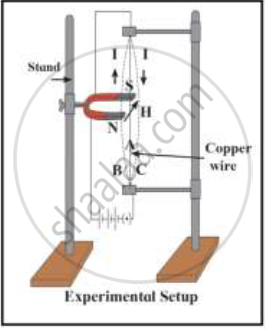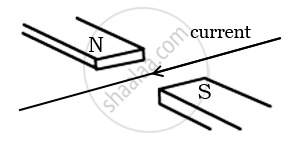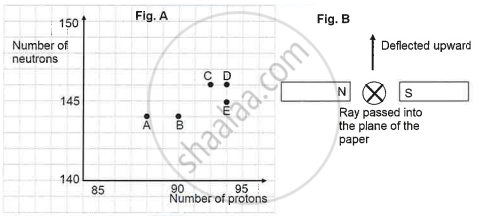Advertisements
Advertisements
प्रश्न
Write Fleming’s left hand rule.
उत्तर
Stretch the index finger, the middle finger, and the thumb of the left hand mutually perpendicular to each other. If the index finger is in the direction of the magnetic field and the middle finger points in the direction of the current, then the thumb will point towards the direction of the force on the conductor.
APPEARS IN
संबंधित प्रश्न
Consider a circular loop of wire lying in the plane of the table. Let the current pass through the loop clockwise. Apply the right-hand rule to find out the direction of the magnetic field inside and outside the loop.
State the rule to determine the direction of a force experienced by a current-carrying straight conductor placed in a magnetic field which is perpendicular to it.
What concealed do you get from the observation that a current-carrying wire deflects a compass needle placed near it?
State qualitatively the effect of inserting an iron core into a current-carrying solenoid.
What is the shape of a current-carrying conductor whose magnetic field pattern resembles that of a bar magnet?
Draw a sketch to show the magnetic lines of force due to a current-carrying straight conductor.
Name any two factors on which the strength of magnetic field produced by a current-carrying solenoid depends. How does it depend on these factors?
What is a solenoid? Draw a sketch to show the magnetic field pattern produced by a current-carrying solenoid.
List three ways in which the magnetic field strength of a current-carrying solenoid can be increased?
The diagram given below represents magnetic field caused by a current-carrying conductor which is:

(a) a long straight wire
(b) a circular coil
(c) a solenoid
(d) a short straight wire
The front face of a circular wire carrying current behaves like a north pole. The direction of current in this face of circular wire is:
(a) clockwise
(b) downwards
(c) anticlockwise
(d) upwards
What happens when a current-carrying conductor is placed in a magnetic field?
In a statement of Fleming's left-hand rule, what do the following represent?
(a) direction of centre finger.
(b) direction of forefinger.
(c) direction of thumb.
The force experienced by a current-carrying conductor placed in a magnetic field is the largest when the angle between the conductor and the magnetic field is:
45°
60°
90°
180°
A current flows in a wire running between the S and N poles of a magnet lying horizontally as shown in Figure below:
The force on the wire due to the magnet is directed:

fron N to S
from S to N
vertically downwards
vertically upwards
Which way does the wire in the diagram below tend to move?

State condition when magnitude of force on a current carrying conductor placed in a magnetic field is maximum?
Name and state the law which is used to determine the direction of force on a current carrying conductor placed in a magnetic field.
A flat coil ABCD is freely suspended between the pole of U-shaped permanent magnet with the plane of coil parallel to the magnetic field.
What happens when a current is passed in the coil?
Name the following diagram and explain the concept behind it.

i) Which principle is explained in this figure?
ii) Which rule is used to find out the direction of a force in this principle?
iii) In which machine this principle is used? Draw a diagram showing working of that machine

Name and state the rule of determine the direction of force experienced by a current carrying straight conductor placed in a uniform magnetic field which is perpendicular to it.
A flat coil ABCD is freely suspended between the pole pieces of a U-shaped permanent magnet with the plane of coil parallel to the magnetic field.
When will the couple acting on the coil be
- maximum
- minimum?
State whether a magnetic field is associated or not around a static charge.
State under what conditions force acting on a current carrying conductor which is freely suspended in a magnetic field can be Zero.
The north pole of Earth’s magnet is in the ____________.
The shape of the magnetic field lines produced by a current-carrying conductor is ____________.
A current flows in a wire running between the S and N poles of a magnet lying horizontally as shown in the figure below:

The force on the wire due to the magnet is directed ____________.
Which of the following factors affect the strength of force experience by current-carrying conduct in a uniform magnetic field?
The direction of force on a current carrying conductor in a magnetic field is given by ____________.
A current-carrying conductor of a certain length, kept perpendicular to the magnetic field experiences a force F. What will be the force if the current is increased four times, the length is halved and the magnetic field is tripled?
Assertion (A): A current carrying straight conductor experiences a force when placed perpendicular to the direction of magnetic field.
Reason (R): The net charge on a current carrying conductor is always zero.
|
The graph (fig A) illustrates the correlation between the number of protons (x-axis) and the number of neutrons (y-axis) for elements A, B, C, D, and E in the periodic table. These elements are denoted by the letters rather than their conventional symbols. When the element C, depicted in the graph, undergoes radioactive decay, it releases radioactive rays. When these rays are directed into the plane of the paper in the presence of a magnetic field, as indicated in the fig B, they experience deflection, causing them to move upwards.
|
Name the law used to identify the radioactive radiation emitted by the element.

